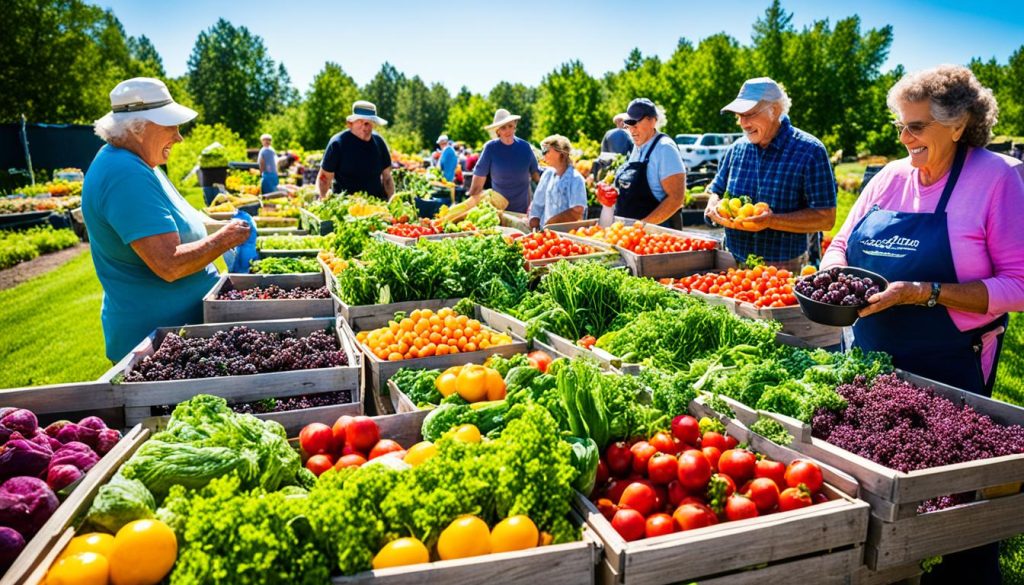Did you know that approximately 1 in 9 Americans struggle with food insecurity?
This alarming statistic highlights the urgent need for community food storage programs that promote sustainable living, enhance local resilience, and prepare for emergencies. These programs play a vital role in ensuring that individuals and families have access to nutritious food, regardless of their circumstances.
In this article, we will explore the importance of community food storage and provide practical guidance on how to organize and run a successful program. By leveraging cooperative efforts, shared resources, and bulk buying, communities can establish a robust system that supports everyone’s access to affordable and healthy food.
Key Takeaways:
- 1 in 9 Americans struggle with food insecurity.
- Community food storage programs promote sustainable living and enhance local resilience.
- Organizing a community food storage program ensures access to nutritious food in emergencies.
- Cooperative efforts, shared resources, and bulk buying are crucial in community food storage.
- This article provides practical guidance on getting started and running a successful program.
Importance of Community Food Storage
Community food storage plays a vital role in fostering cooperative efforts, sharing resources, and enabling bulk buying. By pooling together their resources, communities can save money and ensure that everyone has access to affordable and nutritious food.
One of the key advantages of community storage is the ability to engage in cooperative efforts. When individuals come together, they can leverage their collective resources to establish a more sustainable and resilient food storage system. This community-driven approach empowers individuals to take an active role in securing their food supply and supporting one another.
Shared resources are another essential aspect of community food storage. By sharing storage facilities, communities can optimize the use of available space and reduce costs. This cooperative approach allows individuals and families to contribute their surplus food and resources to benefit the entire community. It fosters a sense of unity and highlights the power of collective action in achieving common goals.
Furthermore, bulk buying is a significant advantage of community storage programs. By purchasing food items in larger quantities, communities can benefit from cost savings and economies of scale. This translates into lower prices for members and ensures that everyone can afford essential food items. Bulk buying also allows for better management of resources, reduces packaging waste, and promotes sustainability.
“Community food storage encourages cooperation, builds stronger communities, and facilitates better access to affordable and nutritious food. It is a transformative approach that empowers individuals and enables them to take control of their food security.”
Community food storage goes beyond individual benefits; it builds solidarity among community members, strengthens local networks, and fosters greater resilience in the face of emergencies or unforeseen circumstances. By working together, communities can mitigate food insecurity, improve access to nutritious food, and promote sustainable living.
Benefits of Community Food Storage:
- Cost savings through cooperative efforts
- Optimal utilization of shared resources
- Affordable access to nutritious food through bulk buying
- Enhanced community resilience and food security
- Promotion of sustainable living practices
| Benefits | Explanation |
|---|---|
| Cost savings through cooperative efforts | Pooling resources allows for bulk purchasing, resulting in lower prices and reduced costs. |
| Optimal utilization of shared resources | Sharing storage facilities enables efficient space utilization, minimizing wastage and expenses. |
| Affordable access to nutritious food through bulk buying | Buying in bulk ensures affordable prices for high-quality, nutritious food items. |
| Enhanced community resilience and food security | By working collectively, communities are better prepared to face emergencies and food shortages. |
| Promotion of sustainable living practices | Community food storage reduces food waste, promotes local sourcing, and supports environmental sustainability. |
Getting Started with a Community Food Pantry Program
To establish a community food pantry program successfully, two key factors are paramount: community support and an organizing committee. The first step is to gain the backing and engagement of the local community in this vital initiative. Garnering widespread community support is crucial to ensure sustained funding, volunteer participation, and active engagement.
Once community support is secured, the next step is to form an organizing committee dedicated to overseeing the program’s implementation and operational aspects. The committee should consist of passionate individuals who possess a range of skills and expertise, enabling them to effectively manage the program from planning to execution.
One essential task of the organizing committee is to develop a comprehensive mission statement that encapsulates the program’s purpose and aligns with the unique needs of the community. The mission statement serves as a guiding beacon, outlining the core values, goals, and objectives of the community food pantry program.
The organizing committee should collaborate to craft a mission statement that reflects the aspirations of the program, such as increasing food accessibility, promoting nutritional education, and fostering a sense of community. This mission statement will provide a clear direction for the program, guiding decision-making, and enabling effective communication with stakeholders and prospective donors.
Community support and a well-formed organizing committee, accompanied by an impactful mission statement, serve as the foundation for a successful community food pantry program.
Example Mission Statement:
At our community food pantry program, our mission is to foster resilience and combat food insecurity by providing equitable access to nutritious food for all members of our community. We strive to create a supportive and inclusive environment that promotes self-sufficiency and empowers individuals and families to thrive.
| Importance of an Organizing Committee | Role |
|---|---|
| 1. Strategic planning and decision-making | Visionary guidance and direction for the program |
| 2. Resource allocation | Effective distribution of funds, donations, and volunteer efforts |
| 3. Community outreach and partnership development | Establishing connections with local organizations, businesses, and individuals |
| 4. Program evaluation and improvement | Continuous assessment to enhance efficiency and effectiveness |
Developing a Service Plan
When establishing a community food storage program, developing a comprehensive service plan is crucial. This plan serves as a roadmap for the program’s operations and ensures that assistance is provided effectively and efficiently. A well-designed service plan should consider various key factors, including the eligibility requirements, geographic coverage, location of the pantry, and the frequency of assistance.
Evaluating Eligibility Requirements
One of the first steps in developing a service plan is determining the eligibility requirements for individuals or families seeking assistance from the community food storage program. These requirements help ensure that the resources are allocated to those who truly need them. To create inclusive and fair eligibility criteria, it is important to consider income thresholds, household size, and any specific circumstances that may affect the need for assistance.
Setting Geographic Coverage
The service plan should clearly outline the geographic area served by the community food storage program. This ensures that the program’s resources are focused on the target community and that assistance is provided where it is most needed. Consider factors such as population density, income levels, and existing food insecurity data when determining the geographic coverage.
Identifying the Pantry Location
Choosing the right location for the pantry is vital to ensure accessibility for individuals seeking assistance. The service plan should identify a location that is central and convenient for the target audience. Consider factors such as proximity to public transportation, availability of parking, and the accessibility of the pantry space for individuals with disabilities.
Determining Assistance Frequency
The frequency of assistance provision should be a key consideration in the service plan. This refers to how often individuals or families can receive support from the community food storage program. It is important to strike a balance between providing regular assistance and avoiding dependency on the program. Consider factors such as the available resources, the needs of the community, and the ability to sustain the program’s operations.
Developing a service plan that addresses eligibility requirements, coverage area, pantry location, and assistance frequency lays the foundation for a well-structured and effective community food storage program. By carefully considering and tailoring these elements, the program can ensure its resources are utilized efficiently and that it effectively meets the needs of the community.
| Service Plan | Key Components |
|---|---|
| Eligibility Requirements | Determining criteria for individuals or families to qualify for assistance |
| Geographic Coverage | Specifying the area served by the community food storage program |
| Pantry Location | Selecting a convenient and accessible location for the pantry |
| Assistance Frequency | Establishing how often individuals or families can receive support |
Acquiring Food for the Program
Acquiring food for the community food storage program is an essential step in ensuring its success. By diversifying food sources, community organizations can maximize the availability of nutritious options for individuals and families in need.
Food Drives
One effective method of acquiring food for the program is through food drives. These initiatives encourage community members to donate non-perishable food items, providing a valuable resource for the community food storage program. Organizing food drives can be done in collaboration with schools, local businesses, and community organizations.
Donations from Local Establishments
In addition to food drives, donations from restaurants, bakeries, convenience stores, grocery stores, and drug stores can also contribute to the food supply. Establishing partnerships with these establishments can create a sustainable stream of donated food items for the community program. Regular communication and coordination with donors can help ensure a consistent supply of food.
Building Relationships with Local Growers
Another valuable strategy for acquiring food is by building relationships with local growers. Partnering with these farmers and agricultural producers not only supports the local economy but also provides a direct source of fresh produce for the program. By prioritizing local growers, community food storage programs can promote a sustainable and environmentally friendly approach to food acquisition.
| Food Source | Advantages |
|---|---|
| Food Drives | Engages the community in donating non-perishable food items |
| Donations from Local Establishments | Provides a consistent supply of food from restaurants, bakeries, convenience stores, grocery stores, and drug stores |
| Building Relationships with Local Growers | Ensures a sustainable source of fresh produce while supporting local farmers and agricultural producers |
By utilizing food drives, donations from local establishments, and building relationships with local growers, community food storage programs can secure a diverse range of food sources to meet the needs of individuals and families facing food insecurity. This multi-faceted approach ensures a well-rounded and sustainable food supply.
Building a Financial Base
Building a strong financial base is crucial for the success and sustainability of a community food storage program. Effective budgeting and fundraising strategies are key to ensuring that the program can cover necessary expenses like transportation and storage costs.
When it comes to budgeting, it’s important to allocate funds wisely and prioritize the program’s needs. By carefully evaluating and estimating expenses, you can ensure that funds are distributed appropriately and that the program remains financially stable.
To raise the necessary funds, organizing fundraisers is a great option. By partnering with churches, schools, businesses, and other organizations in your community, you can create impactful fundraising events that generate financial support for the program.
Here are some fundraising ideas to consider:
- Organize a community bake sale or potluck dinner, where people can share delicious homemade dishes and donate the proceeds to the program.
- Host a charity run or walkathon, encouraging participants to gather sponsors who pledge a certain amount per mile or lap completed.
- Collaborate with local artists and musicians to put on a charity concert or art show, with ticket sales benefiting the program.
- Reach out to local businesses for sponsorships or donations. They may be willing to contribute financially or provide in-kind support, such as offering their space for fundraising events.
By diversifying your fundraising efforts and involving the community, you can raise awareness about the program and garner support from a wide range of individuals and organizations.
Remember to express gratitude to your donors and provide regular updates on how their contributions have made a difference. Building strong relationships with your supporters can lead to long-term financial stability for the community food storage program.
Volunteers and Pantry Operations
Volunteers are the backbone of a successful community food storage program. Their dedication and commitment play a crucial role in ensuring that the program runs smoothly and effectively. One of the key tasks in managing a community food pantry is recruiting volunteers who are passionate about making a difference in their community.
There are various ways to recruit volunteers for your program. Networking is an excellent strategy to tap into existing connections and spread the word about the opportunity to contribute to a meaningful cause. By reaching out to local organizations, schools, places of worship, and community centers, you can connect with individuals who may be interested in volunteering.
It is important to craft a compelling message to attract potential volunteers. Highlight the mission and goals of the community food storage program, emphasizing the positive impact it has on the lives of individuals and families in need. Utilize social media platforms, local publications, and community bulletin boards to spread the word about the volunteer opportunities available.
Intake and Information Gathering
Establishing proper intake procedures is essential for smooth pantry operations. The intake process involves gathering necessary information from clients, such as their contact details, family size, and dietary restrictions. This information helps ensure that the pantry can meet the diverse needs of the community and distribute food efficiently.
When designing the intake process, consider using intake forms that are easy to understand and fill out. Provide clear instructions and offer assistance if needed, allowing clients to comfortably provide the required information. Respect the privacy and confidentiality of clients by implementing secure data management practices.
Distribution Options
Offering distribution options that cater to the diverse needs of the community is crucial. One approach is pre-packing food boxes that contain a variety of essential items, making it convenient for clients to receive a well-rounded selection of food. Another approach is providing client choice, where individuals and families can select the specific items they need, accommodating different dietary preferences and restrictions.
Consider implementing a combination of both options to provide flexibility and choice while ensuring efficient distribution. This can help create a more personalized experience for clients while maximizing the resources available.
Enhancing Pantry Operations
Continuously improving pantry operations is important to maintain effectiveness and meet the evolving needs of the community. Regularly communicate with volunteers to gather feedback and suggestions for improvement. Conduct trainings to enhance volunteers’ skills and knowledge in areas such as client interaction, inventory management, and food safety.
Collaborate with local organizations and businesses to explore partnerships that can support the pantry’s operations. This may include securing donations of non-perishable food items, establishing relationships with local growers and farmers for fresh produce, or partnering with transportation companies for efficient logistics.
By recruiting dedicated volunteers, implementing effective intake procedures, and offering diverse distribution options, a community food storage program can effectively serve its purpose of providing food security to those in need. Engaging the community and incorporating their input helps create a sense of ownership and fosters an environment of support and collaboration.
Conclusion
Establishing a community food storage program is a critical step towards achieving food security, promoting sustainability initiatives, and enhancing emergency preparedness. By coming together and supporting local networks, communities can ensure that everyone has access to nutritious food, even during times of crisis.
Food security is a fundamental aspect of community well-being. This initiative helps address the challenges of food scarcity and ensures that individuals and families have a reliable source of sustenance. By implementing sustainable practices, such as bulk buying and shared resources, community storage programs not only support the immediate needs of residents but also cultivate long-term resilience.
Emergency preparedness is paramount, and having a community food storage program in place contributes to a proactive approach. These programs play a crucial role in safeguarding individuals and communities against unexpected circumstances, such as natural disasters or economic downturns, by providing a stable and accessible food supply. They serve as a safety net, ensuring that no one goes hungry when their circumstances change unexpectedly.
To learn more about the historical origins of food preservation and how it has played a vital role in food security throughout history, visit the National Center for Home Food Preservation. By embracing community food storage programs, we can foster self-sufficiency, strengthen community bonds, and pave the way for a more sustainable future.


